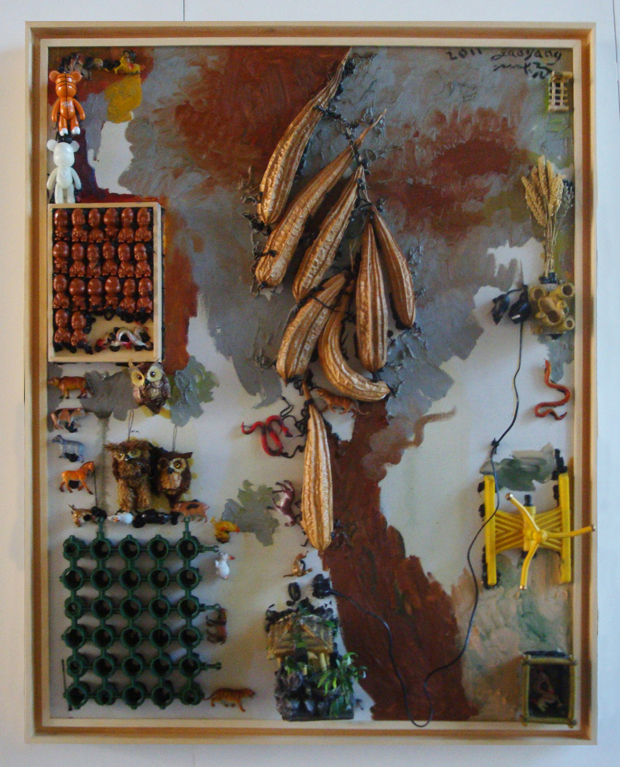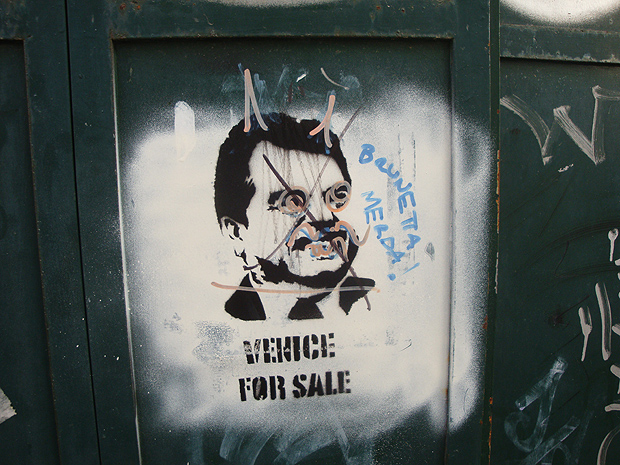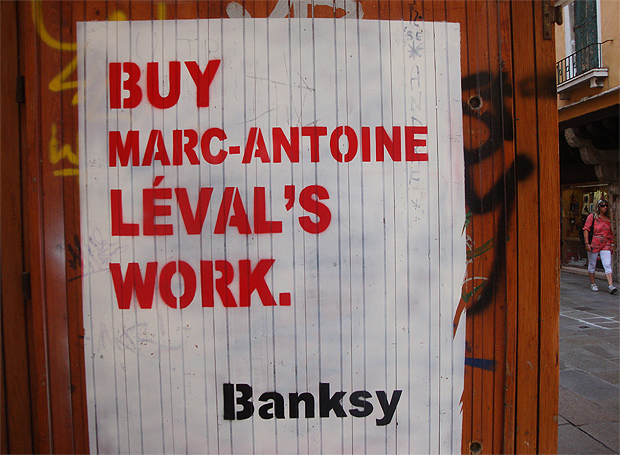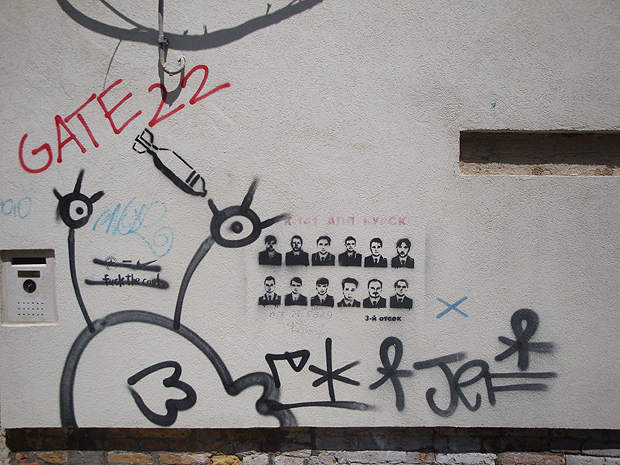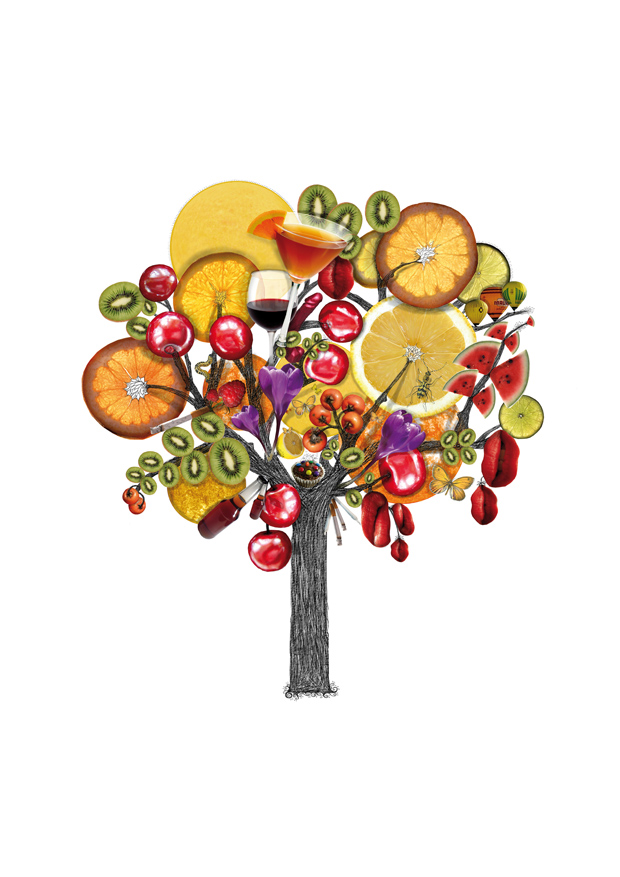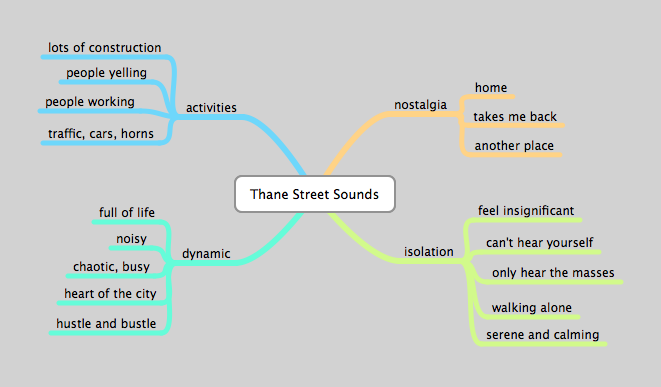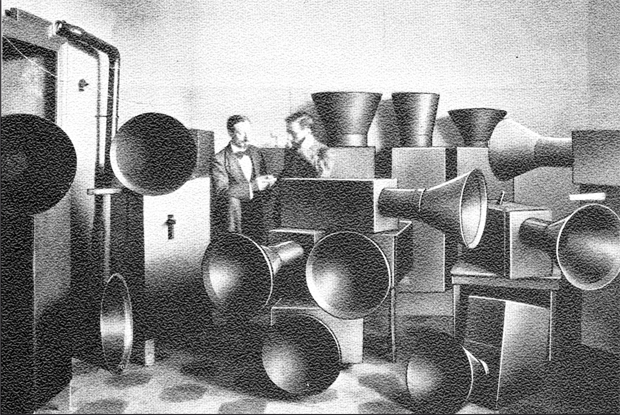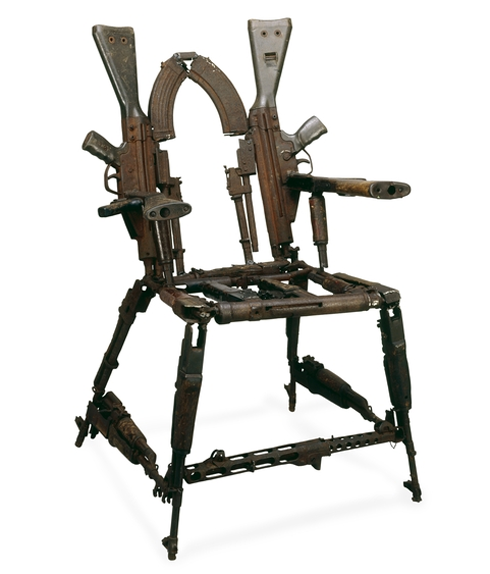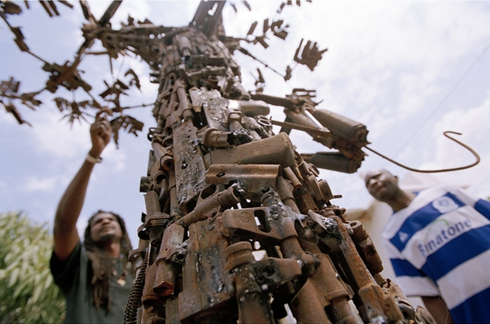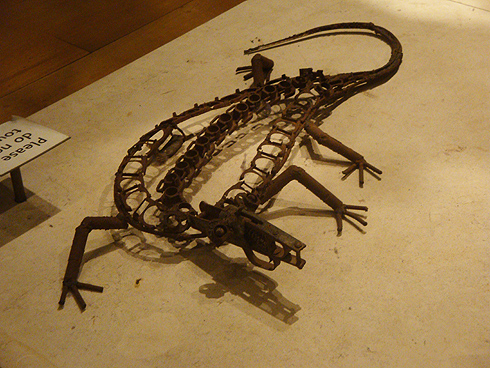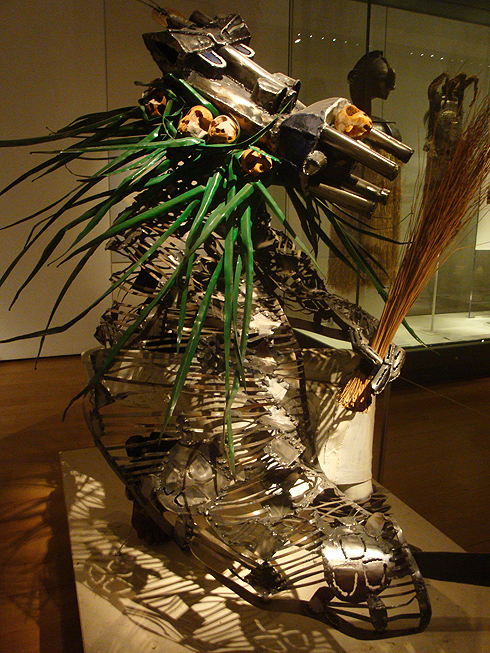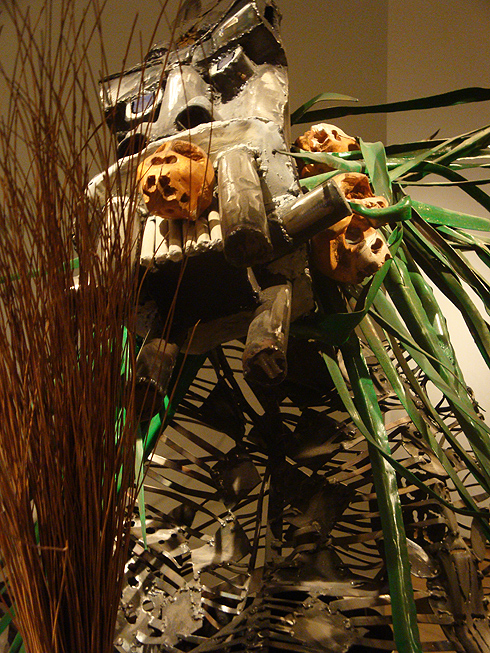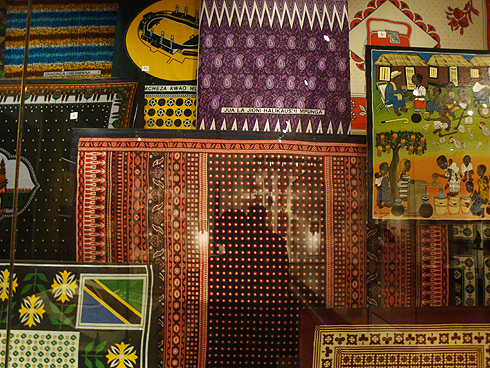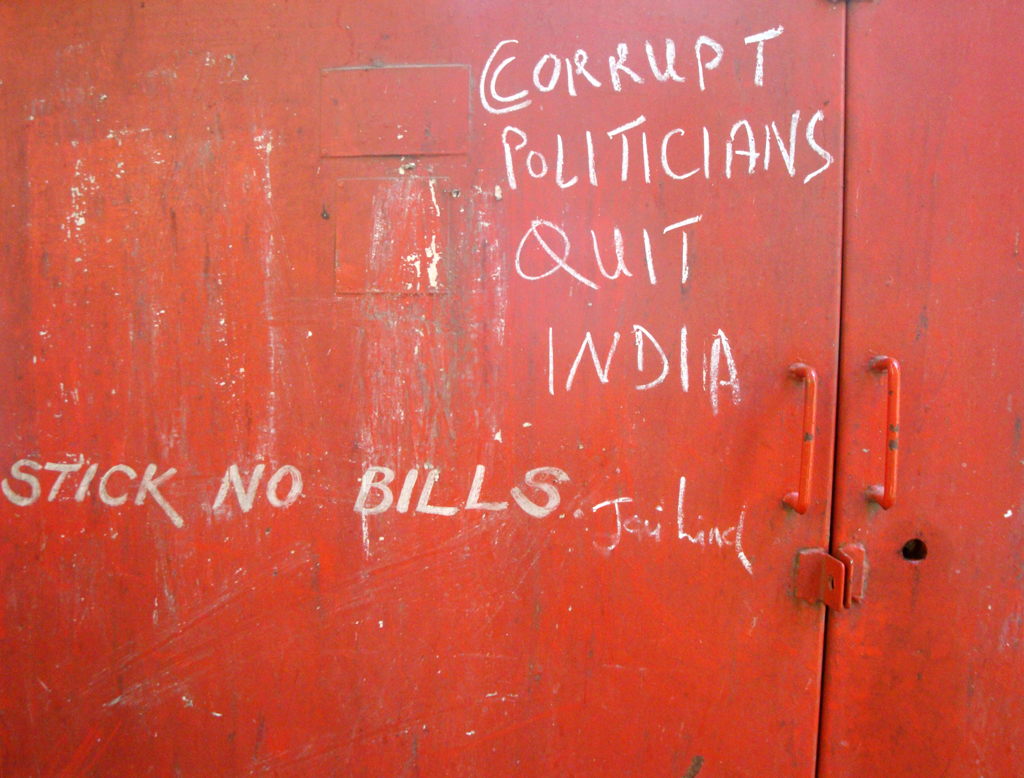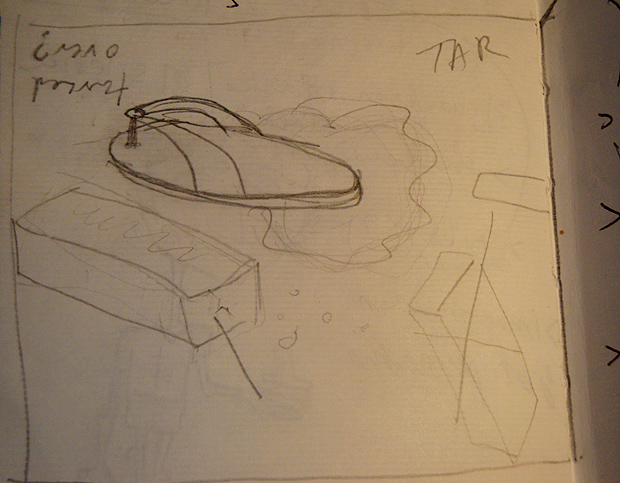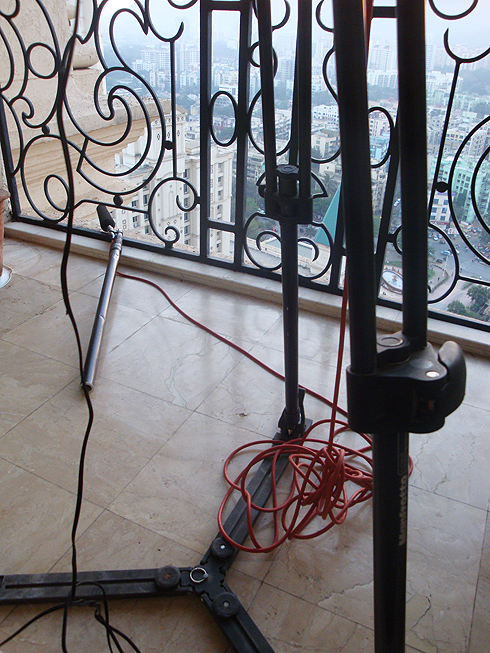Cracked Culture? Contemporary Chinese Art
Cracked Culture? The Quest for Identity in Contemporary Chinese Art. Curators: Wang Lin (China), Gloria Vallese (Italy). Organizer: Guangdong Museum of Art, China. Photos by Aditi Kulkarni.
Cracked Culture? The Quest for Identity in Contemporary Chinese Art. Curators: Wang Lin (China), Gloria Vallese (Italy). Organizer: Guangdong Museum of Art, China. Photos by Aditi Kulkarni.
 Jiao Xingtao. The Powerful Dragon. 258X38X170cm. Mixed Medium. 2011.
Jiao Xingtao. The Powerful Dragon. 258X38X170cm. Mixed Medium. 2011.
 Shi Jindian. Blue 750. Coloured Fibre in Stainless Steel. 260X170X120cm. 2008.
Shi Jindian. Blue 750. Coloured Fibre in Stainless Steel. 260X170X120cm. 2008.
Gao Yang. Jingzhe. Mixed Medium. 210X85cm. 2010.
Gao Yang. Mixed Medium 2011. Mixed Medium. 150X120cm. 2011.
 Ying Tianqi. Memory Loss. Mixed medium. 122X130cm. 2007.
Ying Tianqi. Memory Loss. Mixed medium. 122X130cm. 2007.
 Resi Girardello/ Vanas-Omnia Vincit Vanitas. Work with spun copper enameled in various colors and sizes, metal structure. 200X180X90cm. 2009.
Resi Girardello/ Vanas-Omnia Vincit Vanitas. Work with spun copper enameled in various colors and sizes, metal structure. 200X180X90cm. 2009.
 Ying Tianqi. Traces of the Vicissitudes. 2011.
Ying Tianqi. Traces of the Vicissitudes. 2011.
Ying Tianqi Resurrects the Life of Yore in the Old City on the Spot: "In China, when the bulldozers were marching like an army across the ancient city of Wuhu where I spent my childhood. I determined to shoot the record of this dramatic change with my video camera. Before the old city was demolished, I set my video camera at a sport shooting a street of neibhourhood and the life of a household from dawn till midnight for 12 hours. The same day a year later, that place had turned to ruins, and I played the video on the spot showing the life of people there a year before, both times of which happened to be the Chinese Dragon Boat Festival."
Future Pass
"Over 100 artists, both Asian and non-, offer a kaleidoscopic panorama of a new aesthetic paradigm currently proliferating from Asia to the rest of the world. Crossing genres and disciplines as they appropriate the digital culture of the 21st century, artists working in this eclectic new aesthetic are generating new types of relationships to the globalizing world."- Excerpt from the Short Guide distributed at the exhibition. Future Pass - From Asia to the World. Collateral Event Biennale Arte 2011. June 4th - Nov. 6th 2011.
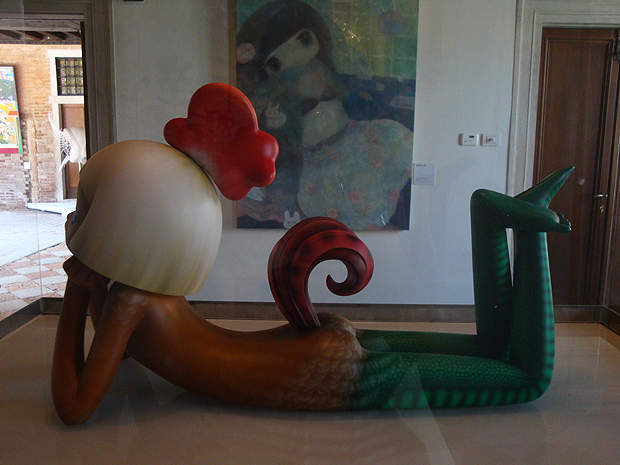 Kaikai Kiki/Chiho Aoshima. 1974-. Little Carefree, The Chicken Girl. FRP, Lacquer. 33X20X53 cm. 2008.
Kaikai Kiki/Chiho Aoshima. 1974-. Little Carefree, The Chicken Girl. FRP, Lacquer. 33X20X53 cm. 2008.
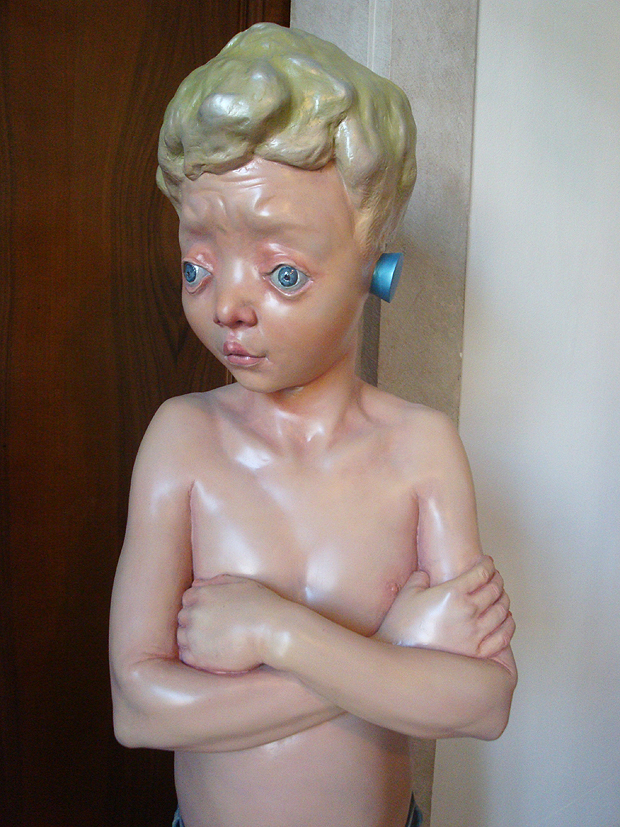 Yan Shi Lin. 1982-. What's the Matter. FiberGlass Paint. 2010.
Yan Shi Lin. 1982-. What's the Matter. FiberGlass Paint. 2010.
The word 'kaleidoscope' is an accurate description of this brilliant collection of work by a wide range of artists from across asia and the world. I spent hours here and didn't regret it for a moment (we had only 5 days to see the entire Biennale). If anyone asked me what the best thing to see in the Biennale was, it would be Future Pass. Several of the artists were also around when we visited, which made it an unforgettable experience.
 Andre Saraiva. 1971-. Mickey Wiagra. Polyester Resin, Strattee a structure - skeleton frame. 198X140X125 cm.
Andre Saraiva. 1971-. Mickey Wiagra. Polyester Resin, Strattee a structure - skeleton frame. 198X140X125 cm.
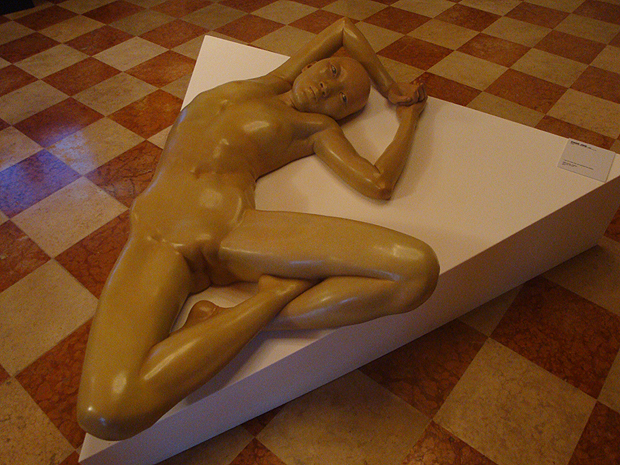 Xiang Jing. 1962-. I am 22 years old, but without my period. Fibre glass painted. 30X155X95 cm.
Xiang Jing. 1962-. I am 22 years old, but without my period. Fibre glass painted. 30X155X95 cm.
 Ward Walrath Kimball. 1914-2002. Untitled. Drawings on found posters. Sizes varied. Made in the 1960's.
Ward Walrath Kimball. 1914-2002. Untitled. Drawings on found posters. Sizes varied. Made in the 1960's.
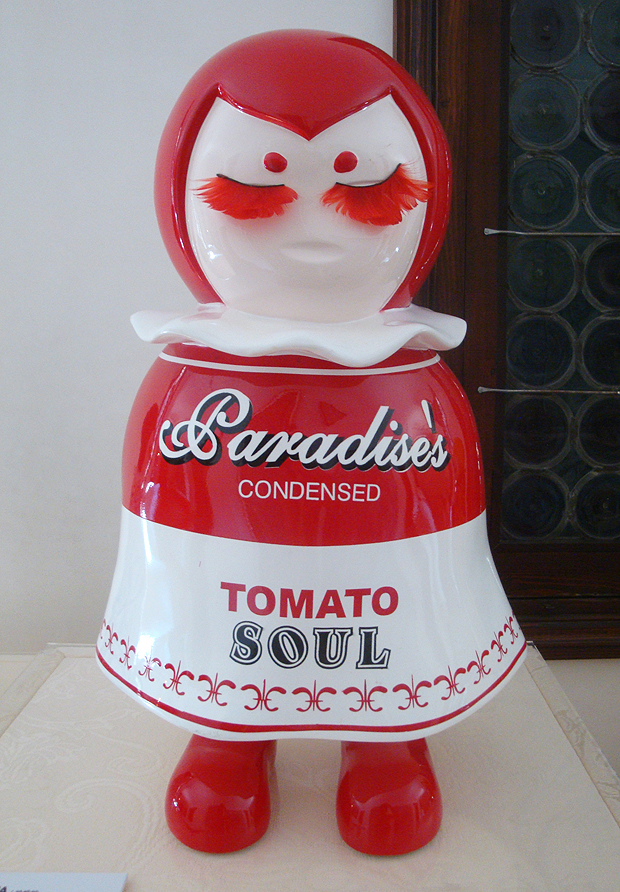 Victor Xu Weina. 1981-. (animamix.net). Magician. Fiberglass paint. 50X22X22 cm X3. 2009.
Victor Xu Weina. 1981-. (animamix.net). Magician. Fiberglass paint. 50X22X22 cm X3. 2009.
Kea. 1980-. A Salute to Fashion. Acrylic on Canvas. 162X130cm. 2011.
Wang Mai. 1972-. Using wisdom to capture the oil monster #12. Mixed material. 160X100X200 cm. 2011. [detail].
 Qu Yi. 1985-. Kiss Me Hard. Series of photographs.
Qu Yi. 1985-. Kiss Me Hard. Series of photographs.
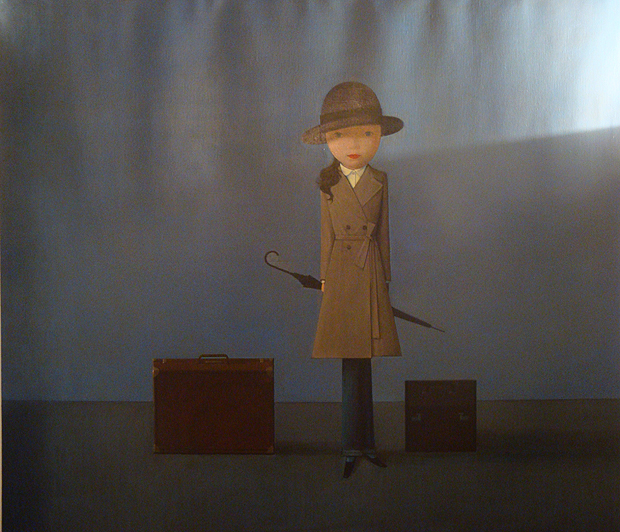 Liu Ye. Miss, 2008. Acrylic on Canvas. 140X160 cm. Private Collection.
Liu Ye. Miss, 2008. Acrylic on Canvas. 140X160 cm. Private Collection.
 Li Hui. 1977-. Motor-Inherent Danger. Acrylics, LED Lamp, Stainless steel. 240X50X50cm. 2008.
Li Hui. 1977-. Motor-Inherent Danger. Acrylics, LED Lamp, Stainless steel. 240X50X50cm. 2008.
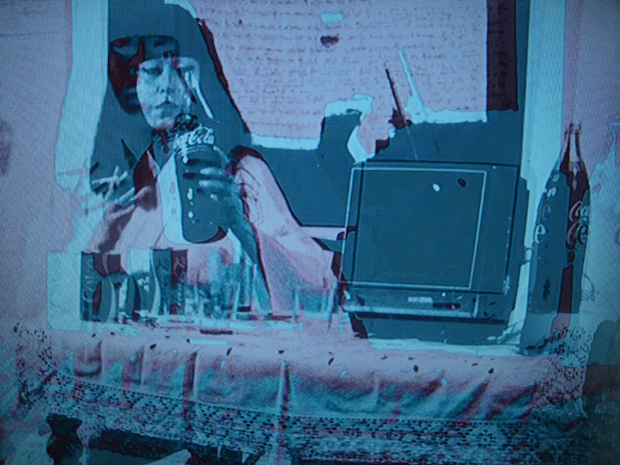 Yoko Toda. 1944-. Unknown Ideal. Video. 2009, 2011.
Yoko Toda. 1944-. Unknown Ideal. Video. 2009, 2011.
 David Chan. 1979-. Feeding the Stupid Monkey. Oil on Linen. 150X180 cm.2010.
David Chan. 1979-. Feeding the Stupid Monkey. Oil on Linen. 150X180 cm.2010.
 Cao Fei. 1978-. RMB City. Since 2009. Internet Project. RMB City is developed by Cao Fei & Vitamic Creative space. Facilitator: Uli Sigg. Courtesy of Artist and Sigg Collection.
Cao Fei. 1978-. RMB City. Since 2009. Internet Project. RMB City is developed by Cao Fei & Vitamic Creative space. Facilitator: Uli Sigg. Courtesy of Artist and Sigg Collection.
 Grimanesa Amoros. Uros Island. 414X340X66cm.
Grimanesa Amoros. Uros Island. 414X340X66cm.
Untitled Installation by Mu Lei. Video projection on a bathtub.
[Future Pass - From Asia to the World. Collateral Event Biennale Arte 2011. June 4th - Nov. 6th 2011. The UNEEC Culture and Education Foundation Taipei, The Today Art Museum of Beijing, The Wereldmuseum of Rotterdam, The National Taiwan Museum of Fine Arts, In Collaboration with the Fondazione Claudio Buziol of Venice, curated by Victoria Lu, Renzo di Renzo and Felix Schober].
The Walls of Venice
Photographs of graffiti and posters on the walls of venice, during the time of the venice biennale.
Exhibition at 60mpc
My poster exhibited at 60 mpc's This is the Start of Summer event.
My illustration work was sold at the event "This is the Start of Summer" at 60mpc, Bournemouth UK. Above are photos of the event and the illustration itself.
Surrealism in Graphic Design
An overview of the talk on surrealism in graphic design by Rick Poynor, founder of eye magazine.
Rick Poynor's talk about Surrealism in graphic design was inspiring and refreshingly idealistic. He is an influential writer on visual culture and founder of Eye magazine. He started off by saying that surrealism is about transforming the world, a kind of 'poetic expression' and document of the 'marvellous'. To surrealists' the term marvellous is something transformative, beautiful and uncanny.

Katastrofa by Roman Cieślewicz (1961). From the archive of the Moravian Gallery in Brno. [Image Source].
Poynor argues that the clinical and grid-based designs being mass-produced today in the UK are a symptom of a much larger social control. The mobile phone that is supposed to free you is actually putting you into a node. He suggested that we should avoid 'submitting to the grid.' Instead he showed us brilliant examples of Polish and Czech graphic designers who created unforgettable images using surrealist elements. There are various ways to create this surrealist feeling: random juxtaposition, doubles, repetition, and of course the use of dolls. The images should make you feel uncomfortable, repelled and at the same time attracted to the work.
From the archive of the Moravian Gallery in Brno. [Image Source].
This image above by Jan Švankmajer is an excellent example of the kind of surrealist work Poynor emphasized in the talk and his earlier exhibition about the same topic.
^ by French artist Marion Bataille. From the archive of the Moravian Gallery in Brno. [Image Source].
Poynor goes on to mention that none of this may be "true" surrealist art since a true surrealist has sworn into the surrealist manifesto. You could say that this use of surrealist imagery in advertising and movie posters is a commodification of such ideals. We cannot deny however that surrealism, even as a term, has diffused into the mainstream, though not necessarily in the way that the original surrealist intended the term and imagery to be used.
Finally Poynor laments the absence of disruptive graphic design in UK and London, especially in the London tube. By encouraging students like us to pursue our individual expression, he hopes for a 'visual culture that reflects humanity in all its complexity.'
Reference
Poynor, R (2011). Surrealism in Graphic Design. Arts University College Bournemouth. 13th May.
Design Observer Blogs. (2010) Uncanny: Surrealism and Graphic Design. Available from: http://observersroom.designobserver.com/rickpoynor/uncanny.html [Accessed 15th May 2011].
Moravian Gallery in Brno. (2010). Uncanny: Surrealism in Graphic Design by Rick Poynor. Available from http://www.moravska-galerie.cz/moravska-galerie/vystavy-a-program/aktualni-vystavy/2010/cosi-tisniveho-surrealismus-a-graficky-design.aspx Accessed [15th May 2011].
Mumbai Noise
I spoke to several people who had never visited India, and collected their reactions to recorded street sounds from Thane. I asked them how the sound made them feel and what it reminded them of.
Noise is 'part of the experience of the urban' (Barry, 2000, p.170). I am interested in how it can be used to transport people to an other place, to create a visual experience with sound alone. In his essay on Noise the author Andrew Barry (2000, p.168) says:
For Russolo, far from seeking to block out this noise, modern composers should listen to it and learn from it. In doing so they should not attempt to produce pure sounds, which were, in his view, 'estranged from life'.
The author states that though during futurist Luigi Russolo's time the modern city was a noisy place, today 'it is increasingly blocked out, dampened down or simply displaced' (Barry, 2000, p.170). It is easy to disagree since in a developing city such as Mumbai we suffer from dangerously high noise levels, a problem that is getting increasingly difficult to contain.
Russolo's futurist manifesto The Art of Noise inspired me to study the topic further. It is fascinating to read his account from 1913, where he literally predicts the rise in popularity of electronica, techno, trance and industrial rock (Russolo, 1967, p.5):
Nowadays musical art aims at the shrilliest, strangest and most dissonant amalgams of sound. Thus we are approaching noise-sound. This revolution of music is paralleled by the increasing proliferation of machinery sharing in human labor. In the pounding atmosphere of great cities as well as in the formerly silent countryside, machines create today such a large number of varied noises that pure sound, with its littleness and its monotony, now fails to arouse any emotion.
[Image Source] ^Russolo's mechanical orchestra.
This lead me to compare the unedited urban Mumbai sounds with Russolo's work with the mechanical orchestra, a relevant example is Risveglio Di Una Città 1913:
It has opened a whole new world in terms of how I can edit raw street sound and the various ways I can integrate it within a space. Using similar fantastical "noise-music" from Mumbai I can create an atmosphere and place that is inherent to the city.
Reference
Ananthakrishnan, G. (2010). Mumbai Diwali Decibel Levels: Cold Comfort. Nov.6th 2010. Digital Journo. [online]. Available from: http://digitaljourno.wordpress.com/2010/11/06/mumbai-diwali-decibel-levels-cold-comfort/ Accessed 14th May 2011.
Barry, A (2000). Noise. In: Pile, S. and Thrift, N. (eds.) City A-Z. London: Routledge.
Naik, Y. and Khera, D. (2011). IIT-B Demands Noise Barriers. Mumbai Mirror. [online]. April 17th 2011. Available from: http://www.mumbaimirror.com/article/2/2011041720110417030951301232b713d/IITB-demands-noise-barriers.html [Accessed: 13th May 2011].
Russolo, L. (1967). The Art of Noise, futurist manifesto 1913. [pdf]. Something Else Press. Available from: http://www.ubu.com/historical/russolo/index.html [Accessed 13th May 2011].
Rebello, S and Lohade. U. (2011). Sound and fury in Mumbai. Hindustan Times Mumbai. [online] April 20, 2011. Available from: http://www.hindustantimes.com/StoryPage/Print/687364.aspx [Accessed 12th May 2011].
Wikipedia (2011). The Art of Noises. Available from: http://en.wikipedia.org/wiki/The_Art_of_Noises [Accessed 13th May 2011].
A Short History of the Shadow
In this book the author explains the history and meaning behind the shadow in western art. Beginning with the shadow's role in the origin of painting, Victor I.Stoichita covers its symbolic significance across history, from Renaissance painters to Picasso, Warhol and even Piaget's child psychology. Over time he explains how the shadow came to represent negativity, or how the shadow was demonized. The excerpt below is from the first chapter which deals with the earliest representations of the shadow, infused with magical properties, and at times representing the soul.
"...As Maspero reminds us in his classic study, the shadow was how the Egyptians first visualized the soul (ka). In this case it was a 'clear shadow, a colored projection, but aerial to the individual, reproducing every one of his features'. And the black shadow (khaibit), having been regarded in even earlier times as the very soul of man, was subsequently considered to be his double." [pg 19]
An interesting point brought up was the difference between a shadow in sunlight and a shadow at night. He says "..a shadow in sunlight denotes a moment in time and no more than that, but a nocturnal shadow is removed from the natural order of time, it halts the flow of progress." This is relevant because day versus night is a recurring theme in my work since October last year. It also reminded me of the work Tobari no Akari, which to me signified stillness and a frozen moment in time due to the use of nocturnal shadows.
The author's comparison of specular representations with the shadow is also relevant to my work. For example mirrors and reflections in water represent a double (mimesis or likeness) of the real object or person, whereas the shadow can represent the other: "The frontal relationship with the mirror is a relationship with the same, just as the relationship with the profile was a relationship with the other." Giorgio Vasari, The Origin of Painting, 1573, fresco Casa Vasari, Florence.[pg.41]
The book lead me to question the role and significance of the shadow in my work. I've used the shadow in my first installation as a negative symbol to represent the darker hidden city. Whereas in collaborative work such as Tobari no Akari and concept work Beedi Leaf the significance is contextual and at times open to interpretation. Similarly the author underlines the changing meaning of the shadow, "...we could say that to Lippi the shadow as a symbol, is an interminably interpretable symbol." [pg.82]
Although my study of the shadow as a signifier will continue, I cannot find much information about the history of the shadow in Indian or Eastern Art. Besides brief excerpts on shadow puppetry I've discovered only limited information on the significance behind this ancient tradition.
Update: More on the significance of the shadow in the east here.
Reference
Stoichita,V (1997). A Short History of the Shadow. London: Reaktion Books Ltd.
Turner,C and Stoichita,V (2007). A Short History of the Shadow: Interview with Victor I. Stoichita. Cabinet Magazine Issue 24 [online] Available from http://www.cabinetmagazine.org/issues/24/stoichita.php [Accessed 26th April 2011].
Warner, M (2007). Darkness Visible Cabinet Magazine Issue 24. [online] Available from http://www.cabinetmagazine.org/issues/24/Warner.php [Accessed 26th April 2011]
Laundry Room City
![]() Participants: Michael Moore, Samantha Else, Baran Saragul, Rina Miyake, Ben O'Shea, Taro Morimoto, Yi Lu, Tanya and me.
Photos by Samantha Else and me. Paper-mache dolls and houses by Yi Lu. Video and installation set-up by Aditi Kulkarni.
Participants: Michael Moore, Samantha Else, Baran Saragul, Rina Miyake, Ben O'Shea, Taro Morimoto, Yi Lu, Tanya and me.
Photos by Samantha Else and me. Paper-mache dolls and houses by Yi Lu. Video and installation set-up by Aditi Kulkarni.
Since I live in a building full of artists, I decided to invite everyone to one of my spontaneous experiments with the Mumbai videos. Using objects I found in the laundry room such as pieces of thermocol, cardboard boxes, chairs, clothespins and piles of yellow pages I created a crowded, urban space. No sound was used since I couldn't find speakers. After the first thirty minutes of discussion and feedback, people started adding and subtracting to the work, literally "playing" with the objects I had collected and even adding their own. Overall it was exciting since I felt it was relevant to the process of literally "building" a city which is unplanned and crowded like Mumbai, filled with so many different people. Eventually Yi Lu added her own work to the installation; fantasy objects such as houses and dolls made of paper-mache.
This event lead to the collaborative work Tobari no Akari by Taro Morimoto, Yi Lu and me. It also formed the base for my later experimentation with City Memories. Sam and Michael came up with the suggestion to use lego, which lead to Lego city #1.
Installations & Inspiration
Gerry Judah Paintings.
Fire with Fire (2010) by Isabelle Hayeur 3 channels video installation. Video projection of 15 minutes playing in continuous loop. 3 Blu-ray players, 3 video projectors. 112 West Hastings Street, Vancouver. Fire with Fire has been commissioned by The Vancouver 2010 Cultural Olympiad. Curator : Marlene Madison.
Rosa Barbara at Tate Modern. Article about the work here.
Show Homes and Display Desire (2007) by Vesna Pavlović. "Within the “Display, Desire” installation, the prints simultaneously function as images of display and display of images. Strange details of the American home are exposed, through the language of cinema and mechanisms of projection. The projection of black and white transparencies onto semi-transparent Plexiglas screens suggest the plastic quality of the interiors, and within the overlapping projection spaces, the images transform, exploring possible representations of the photographic medium itself."
Art Direction & Visuals: Deniz Kader – Candaş Şişman, Music & Sound Design: Görkem Şen, Project Management: Erdem Dilbaz, Modelling: Gökhan Uzun – Can Dinlenmiş (prospektif.org)
JR's (French Street Artist) TED Prize Wish: Use Art to turn the world Inside Out.
Group Critique
During the group critique I spoke about projecting the filmed cityscape outdoors, and the importance of capturing the essence of the city. Leigh Clarke reacted with a wide range of comments about the work. His main point was that the sound was more powerful than the time-lapse video since it allowed the audience to imagine a larger, more ambiguous space.
He also mentioned that my background as a privileged member of society, and the subsequent "god-like" perspective referred to the panopticon and I should be cautious about the meanings inferred from such choices. Tracey Emin's Folkstone work was mentioned in relation to illustrating a place by using one powerful symbolic object. Leigh Clarke felt that I should focus on a particular object or section of the city instead of trying to describe the entire "forest." He commented that I needed to have an original view of the city rather than something which has been seen before. Ai Weiwei's work Sunflower Seeds 2010 was also mentioned, however I am of the opinion that the work has little relation to mine since I'm looking at sharing the darker, hidden city. In terms of capturing essence however the work is relevant due to the clever play on porcelain versus sunflower seeds, and the issue of handcrafted versus mass-industrialization.
Overall the critique was motivating and provocative because he challenged my project at every level. I explored whether I could go ahead without the visual aspect altogether and looked at various installation concepts that would center around sound as a medium. Another important conclusion was that giving the audience too much information reduced the impact of the work. Overall I realized much more experimentation and research is needed before I can confidently defend my work.
Reference:
Bentham, J (1791). Panopticon Or the Inspection House Vol1 [ebook]. University of Lausanne. Available from: http://books.google.com/ebooks [Accessed 23rd April].
Calvino, I (1997). Invisible Cities. New Edition. London: Minerva.
Emin, T (2008) Baby Things [online] Available from http://www.folkestonetriennial.org.uk/2011-event/artists/2008-tracey-emin/ [Accessed 23rd April 2011].
Foucault, M (1977). Discipline & Punish: The Birth of the Prison [online] Translated from French by Alan Sheridan. Available online from http://www.cartome.org/foucault.htm [Accessed 23rd April 2011].
Kennedy, M (Jan 2011). Ai Weiwei's Sunflower Seeds to go on sale at Sotheby's [online] Available from http://www.guardian.co.uk/artanddesign/2011/jan/26/ai-weiwei-sunflower-seeds-sothebys?INTCMP=SRCH [Accessed 23rd April 2011].
Tate Modern (2010). The Unilevel Series: Ai Weiwei [online] Available from http://www.tate.org.uk/modern/exhibitions/unileverseries2010/default.shtm [Accessed 23rd April 2011].
Place-Making
Notes on urban memory, place-making and its relation to the interpretation of the city in contemporary art and architecture.
During my tutorial with Ronnie Inglis we spoke about the meaning behind the autobiographical trend in my work and further topics of study, especially in relation to place-making. We discussed my previous areas of interest such as the city and fantasy, collective versus personal urban memories, place-making in relation to site-specific art, use of the shadow, and representing extremes. He directed me towards the book History of the Shadow which greatly influenced my work in the following weeks. The topic of Genius loci is relevant because I am interested in shooting my projections in outdoor locations. According to Thompson (2003, p.67) 'the Romans believed that places, like people, had inner spirits that determined their essences,' and similarly I was interested in this essence of Mumbai. Thompson also mentions that for genius loci to be useful rather than a mere magical notion it should be a combination of 'character, local distinctiveness and ecosystem' (2003, p.69). This lead to the idea of representing the city as a fictionalized creation, in the same way a writer creates a fictional character.
And a thing's character changes and develops over time. This can happen slowly or through abrupt events. The reading made me realize that Mumbai has not developed slowly or without trauma. It has grown in bursts and starts. Several traumatic events such as the '93 bombings and the more recent 26/11 Taliban attack have affected the city. We could argue however, that despite these severe shocks the essence of the city remains the same. According to Norberg-Schulz (cited in Thompson, 2003, p.70) "places can change, sometimes rapidly, but this does not necessarily mean that the genius loci changes or gets lost."
An excellent example of the genius loci being kept intact by an architect is the above landscape park Landschaftspark Duisburg-Nord by Peter Latz. The place was 'traumatized by industrialization and deindustrialization' and the architect built upon 'its existing character, creating fern gardens in ore bunkers and making their mass concrete walls into facilities for rock climbers' (Thompson, 2003, p.72). This connects to my idea of using appropriate objects, materials and sites that are relevant to the trauma and violence of the city.
^Cotton 56, Polyester 84 is a play about how the failed Mumbai Mills are getting converted into malls and entertainment complexes. Citizen's groups demand that the land should be converted into open parks and low cost housing, but slowly and surely all mill land will be sold to builders (Shanbag, 2006).
^Another abandoned Mumbai Mill.
As sites these are beautiful and tragic places that express this violent and crushing conflict between the here and the elsewhere, the undesirable and the desired. I can only pursue this direction further once I am back in India. At the same time it brings me to question my interest in these places, since my knowledge of these events is purely historical, through media reports and local people's opinions. At this point in my practice I would prefer to express issues and places that I have personally and directly experienced.
Another important aspect of place is memory, which is in turn closely related to history. Historical buildings such as the mills compounds and their replacements are part of a general history of the city. Individual memories have a completely different flavour. In the book City of Collective Memory the author underlines this difference by proposing that history and memory are bipolar attributes because history is linear and memory non-linear (Boyer, 2001, p.67). Collective memory is 'a current of continuous thought still moving in the present, still part of a group's active life, and these memories are multiple and dispersed, spectacular and ephemeral, not recollected and written down in one unified story' (Boyer, p.67).
Another fascinating point is that this urban memory is 'an antimuseum and not localizable' (Boyer, p.68). This means that my earlier work using popular landscapes and landmarks was a reference to history, a revision of a recognizable historical reality. It is also a reference to memory since I have taken various historical elements and placed them in a contemporary context. Now that I am using scenes that are not famous or instantly recognizable such as the Thane landscape I am removing "historical" elements from the work.
The next topic is framing. We frame the place or city 'by travel, in the theater, at the museum, from the cinema, through its architectural compositions' (Boyer, p.70). The panorama as a framed image is questionable - the city of the panorama is criticized for its 'rational scientific methods,' 'describable pasts' and 'predictable futures' (Boyer, p.68). The author criticizes common recycled views of the city saying 'We have learned to gaze upon the city as artifact through illustrated portfolios and architectural guidebooks that have their own procedures for characterizing place and tradition' (Boyer, p.69).
And finally I'll quote Victor Burgin (1996, p.7) who says that 'we cannot know a 'city', only those of its places we come to frequent.'
Reference
Boyer, C (2001). The City of Collective Memory, Its Historical Imagery and Architectural Entertainments. MIT Press.
Burgin, V. (1996). Some Cities. London: Reaktion Books Ltd.
Thompson, I. (2003). What use is the genius loci? In: Menin, S.(eds). Constructing Place, Mind and Matter. London: Routledge. pp.66-76.
Pile, S. and Thrift, N. (2000). City A-Z. London: Routledge
Wikipedia. (2011). Urbanism [online] Available from http://en.wikipedia.org/wiki/Urbanism. [Accessed 23rd April 2011].
Modern Drawings
Drawings of life in the city, and abstract dream cities. From the exhibition Picasso to Julie Mehretu, modern drawings from the British Museum collection [7th Oct 2010 to 25th April 2011].
 People in a Cafe, 1917 by George Grosz. [Image Source]
People in a Cafe, 1917 by George Grosz. [Image Source]
 Dreamland Tower, Coney Island 1912 by David Milne (1882-1953). [Image Source]
Dreamland Tower, Coney Island 1912 by David Milne (1882-1953). [Image Source]
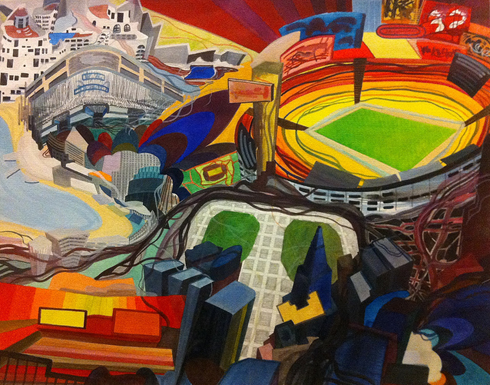 Untitled (Pacific No. 32, weekend), 1998 by Franz Ackermann. [Image Source]
Untitled (Pacific No. 32, weekend), 1998 by Franz Ackermann. [Image Source]
 Untitled (City Abstraction) 1912 by Abraham Walkowitz. [Image Source]
Untitled (City Abstraction) 1912 by Abraham Walkowitz. [Image Source]
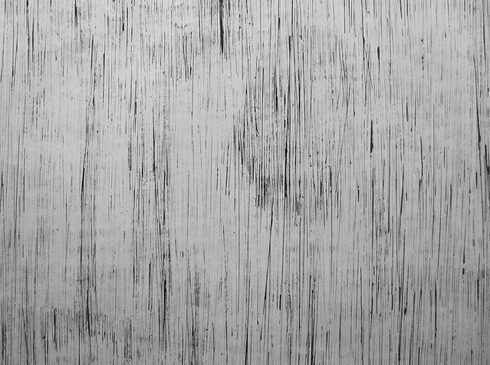 Vertical Lines 1953 by Kazuro Nakamura. [Image Source]
Vertical Lines 1953 by Kazuro Nakamura. [Image Source]
 Untitled by Lawrence Weiner (born 1942) [Image Source]
Untitled by Lawrence Weiner (born 1942) [Image Source]
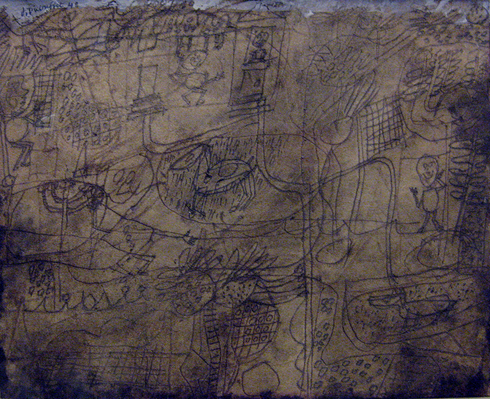 Grotesque Landscape in Yellow 1949 by Jean Dubaffet (1401-85) Pen and ink on yellow watercolour. [Image Source]
Grotesque Landscape in Yellow 1949 by Jean Dubaffet (1401-85) Pen and ink on yellow watercolour. [Image Source]
Update 4th May: I've only included work that is relevant to my project on representing the atmosphere of the city. In my journey towards representing the violence between the fantasy and the real within Mumbai, I've noticed a trend towards abstraction especially with the increasing use of shadows and reflections within the installation. These drawings capture this urban feeling in their own individual expressionist ways.
Museum Visit
A trip to London ended up at the British museum. Most of the work I found inspiring were from the Africa rooms:
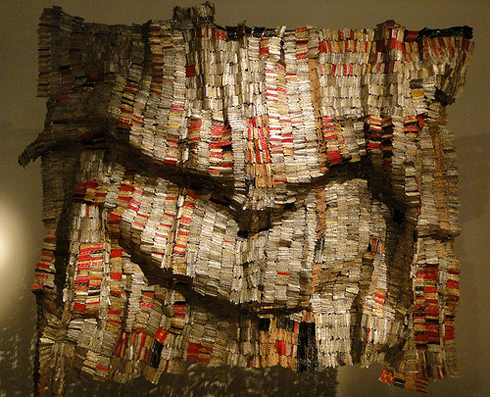
Man's Cloth. Recycled metal foil bottle-neck wrappers, copper wire. By El Anatsui, Ghana, 1998-2001. Image 1 Source. Detail photograph taken at the British Museum April 2011.
Throne of weapons, by Kester, Maputo, Mozambique, 2001. Made of decommissioned weapons from the Mozambican civil war in 1992. Exhibited at Room 25 Africa at the British Museum (April 2011).
Tree of Life Made by Kester, Hilario Nhatugueja, Fiel dos Santos and Adelino Serafim Maté. Maputo, Mozambique, 2004. Photo © 2005 Christian Aid / David Rose.
Part of the sculpture Tree of Life Made by Kester, Hilario Nhatugueja, Fiel dos Santos and Adelino Serafim Maté. Maputo, Mozambique, 2004. Photo by Aditi Kulkarni at the British Museum Room 25: Africa.
Otobo (Hippo) masquerade, made by Sokari Douglas Camp, 1995. Steel, paint, wood and palm stem brooms. British Museum April 2011. More details.
Glazed stoneware figure of a judgement group, Ming Dynasty, China, 16th century. Photo taken at British Museum, Asian Gallery.
Housepost, Iatmul people, Sepik River, Papua New guinea, 1900-1950.
Kanga display, Africa room, British Museum, April 2011.
Dark Stuff
I stumbled on the work Dark Stuff (2008) while looking at random postcards being sold at the British Museum in London. Tim Noble and Sue Webster had created an impressive image inspired by Egyptian mummies, and it motivated me to look for more of their work. Then I found Sunset in Manhattan (2003).
Dark Stuff, 2008 by Tim Noble and Sue Webster 189 mummified animals (67 field mice, 5 adult rats, 42 juvenile rats, 44 garden shrews, 1 fox, 1 squirrel, 1 weasel, 13 carrion crows, 7 jackdaws, 1 blackbird, 1 sparrow, 1 robin, 1 toad, 1 gecko, 3 garden snail shells), glue, metal stands, light projector [Visit Image Source]
Sunset over Manhattan, 2003 Cigarette packets, tin cans shot by air gun pellets, wooden bench, light projector 110 x 31 x 75 cm (431/3 x 121/4 x 291/2 in) [Visit Image Source]
Here the use of rubbish combined with light and shadow creates a city that is recognizable as Manhattan, and at the same time makes an important comment about the place itself. At this point in my project I explored the use of objects in my installations and what kind of objects would be relevant to the concept of the fantastical and the real.
Genius Loci
In phase one I succeeded in defining my area of study, learning about projecting video, building installations, and the limitations involved. Phase two is about capturing a "feeling" of Mumbai. But what is this feeling, this intangible "sense of place," and how can I create a space that communicates it effectively. The city is a multi-layered, complex and rich experience. No one has identical perceptions of something that is so much in flux, so huge in scale. At the same time there is an underlying recognition of its flavour, a distinctive personality that can be called its Genius Loci. In trying to pinpoint this atmosphere of Mumbai, something which is intrinsic in my memories of the city, and which all Mumbaikars are familiar with, I questioned my original plan of building a 360 panorama in a closed studio space.
An outdoor location is one of the ways I plan to solve this riddle. Although it is technically difficult to build an installation outside a controlled studio set-up, I am of the opinion that the right place can physically represent the city, and communicate a lot more than well-edited video or sound ever could.
Place-making is discussed in detail here.
Reference
Menin, S. (2003). Constructing Place Mind and Matter. London: Routledge.
Mumbai Memories
After noticing the autobiographical trend in my work, I looked at my past posts on Mumbai. I've kept a partially anonymous life blog since 2009 and this became an important resource for me to remember what images and events I felt were important enough to blog about. The oldest posts about Mumbai are from August 2009. I've inserted some photographs from the life blog below:




Update April 27th: The image below is a sketch of a concept inspired by one of my school memories of Mumbai. While travelling on the school bus, we stopped to drop off a student and I noticed a single chappal on the tar road. There was a small pool of bright blood beneath it, and a few bricks lying around it. I wondered what happened, and guessed that there had been an accident recently, and these were the leftovers. It had definitely happened recently, but no crowd of onlookers remained and the traffic on the road avoided the single slipper and bricks easily. The idea is to recreate this memory as I remember it, with the blood being bright and overshadowing the rest of the details within the picture.
Personal Bibliography
A complete alphabetical list of relevant books, articles, websites, film, video, exhibition, journals and lectures referenced in Phase 1 of the MA Interactive Media course.
A list of relevant books, articles, websites, film, video, exhibition, journals and lectures referenced in Phase I, Phase II and Phase III. More links on my delicious account.
Ali, Atteqa. Postmodernism: Recent Developments in Art in India. InHeilbrunn Timeline of Art History. New York: The Metropolitan Museum of Art, 2000–. http://www.metmuseum.org/toah/hd/pmin/hd_pmin.htm (October 2004)
Ananthakrishnan, G. (2010). Mumbai Diwali Decibel Levels: Cold Comfort. Nov.6th 2010. Digital Journo. [online]. Available from: http://digitaljourno.wordpress.com/2010/11/06/mumbai-diwali-decibel-levels-cold-comfort/ Accessed 14th May 2011.
Ashraf, K Kazi. (2005) Masala City: Urban Stories from South Asia. The New Mix: Culturally dynamic architecture, Sara Caples and Everardo Jefferson, Architectural Design. Vol 75, No 5 Sept/Oct 2005, pp.67-68.
Barry, A (2000). Noise. In: Pile, S. and Thrift, N. (eds.) City A-Z. London: Routledge.
Barjatya, S. (2003). Mein Prem Ki Diwani Hoon. [Film]. India: Rajshri.
Bendikson, Jonas. (2008). The Places We Live [online]. Available from: http://www.theplaceswelive.com/ [Accessed 1st Nov. 2010] Dominic M. McIver Lopes. (2001).
Bentham, J (1791). Panopticon Or the Inspection House Vol1 [ebook]. University of Lausanne. Available from: http://books.google.com/ebooks [Accessed 23rd April].
Benjamin, A. (2010). Trauma within the Walls: Notes towards a Philosophy of the City. Architectural Design. Vol. 80. No.5. pp.24-31.
Bickle, B. (2011). Seeing Ourselves. Zimbabwe Pavilion: Venice
Bombay Railway. Episode 1. Pressure. (2007). UK. BBC Four. 9th Sept. 2007. [Television]
Boyer, C (2001). The City of Collective Memory, Its Historical Imagery and Architectural Entertainments. MIT Press.
Blazwick, I. (2001). Century City: Art and Culture in the Modern Metropolis. London: Tate Gallery Publishing Ltd.
Burgin, V. (1996). Some Cities. London: Reaktion Books Ltd.
Bugada and Cargnel. (2011). Nico Vascellari. [online]. Available from: http://www.bugadacargnel.com/en/pages/artistes.php?name=21891. Accessed 21st June 2011.
Burke, A. (2010). The Urban Complex: Scalar probabilities and Urban Computation. Architectural Design. Vol. 80. No.5. pp.87-91.
Calvino, I (1997). Invisible Cities. New Edition. London: Minerva.
Cole, D. (2007). Patterns: New Surface Design. London: Lawrence King Publishing
Cotter, H. (2005). Objects of Repose and Remembrance. New York Times. [online]. Available from: http://www.nytimes.com/2005/03/30/arts/design/30cott.html?ex=1172638800&en=840b508f152bce9e&ei=5070 Date Accessed: 21st July 2011.
Danto, A. C. (1995). After the End of Art: Contemporary Art and the Pale of History. Princeton, New Jersey: Princeton University Press.
Dali, S. (2011). The Dali Universe. Venice: Fondazione Ambrosiana Per L’Arte E La Cultura
Degen, N. (2008). Dayanita Singh. Frieze Magazine. [online]. Available from: http://www.frieze.com/shows/review/dayanita_singh/. Accessed: 21st July 2011.
Design Observer Blogs. (2010) Uncanny: Surrealism and Graphic Design. Available from: http://observersroom.designobserver.com/rickpoynor/uncanny.html [Accessed 15th May 2011].
Dictionary of Media Studies (2006). p. 121. A&C Black Publishers: London
Emin, T (2008) Baby Things [online] Available from http://www.folkestonetriennial.org.uk/2011-event/artists/2008-tracey-emin/ [Accessed 23rd April 2011].
Eddistribution (2008) Robinson dans l'espace de Patrick Keiller [online]. Available from: http://www.youtube.com/watch?v=wBHgQBBgogc [Accessed 11th Jan 2011].
Foucault, M. (1984) Des Espace Autres. Architecture /Mouvement/ Continuité. [online] Oct. 1984. Translated from French by Jay Miskowiec. Based on a lecture by Michel Foucault on March 1967. Available from: http://foucault.info/documents/heteroTopia/foucault.heteroTopia.en.html. [Accessed 5th Jan 2010]
Foucault, M (1977). Discipline & Punish: The Birth of the Prison [online] Translated from French by Alan Sheridan. Available online from http://www.cartome.org/foucault.htm [Accessed 23rd April 2011].
Galerie Leonard & Bina Ellen Art Gallery (n.d.). Ways of Thinking: Works. [online] Available from: http://ellengallery.concordia.ca/en/reflexion_hadjithomasjoreige.php [Accessed 18th Dec. 2010]
Green, C. (2001). The Third Hand: Collaboration in Art from Conceptualism to Post-Modernism. University of Minnesota Press: USA.
Hales Gallery. (2010). Dawn Clements: Still Life. London: Hales Gallery
Hirschhorn, T. (2011). Crystal of Resistance. Biennale Di Venezia, Padiglione Svizzero.
Hong-Kai Wang. (2011). Music While We Work. Venice: Palazzo Delle Prigioni.
Johar, K. (1998). Kuch Kuch Hota Hai. [Film]. India: Dharma Productions.
Kaye, N. 2000. Site-Specific Art: Performance, Place and Documentation. Routledge: London
Kennedy, M (Jan 2011). Ai Weiwei’s Sunflower Seeds to go on sale at Sotheby’s [online] Available from http://www.guardian.co.uk/artanddesign/2011/jan/26/ai-weiwei-sunflower-seeds-sothebys?INTCMP=SRCH [Accessed 23rd April 2011].
Kitwise. (2010). Summertime 1-4 [online]. Available from: http://www.youtube.com/watch?v=hWlk1KIysqQ&feature=player_embedded#! [Accessed 11th Jan 2011].
Kit Wise. (2010). Xanadu [online] Available from: http://www.kitwise.com/ [Accessed 10th Jan 2011].
Lang, F. (1927). Metropolis. [Film]. Germany: Universum Film.
Lahoud, A. (2010). Post Traumatic Urbanism. Architectural Design. Vol. 80. No.5. pp.14-23.
luxmovingimage. (2009). Chris Welsby – Artist Interview. [online]. Available from http://www.youtube.com/watch?v=o3fdZewJc3Y&feature=player_embedded#at=20 [Date accessed 3rd April 2011]
Merleau-Ponty. 1962. Phenomenology of Perception. Routledge: London.
Muybridge, E. (2010). The Panorama of San Francisco from Street Hill 1878. Eadward Muybridge. London: Tate Britain
Malani, Nalini. Remembering Toba Tek Singh. (1998). Installation view Queensland Art Gallery, Brisbane, Australia. 2002 [Installation with video projection on walls, 12 monitors with video clips, tin trucks, quilts, and Mylar flooring]
Mazumdar, Ranjani. Bombay Cinema : An Archive of the City. Minneapolis, MN, USA: University of Minnesota Press, 2007. p 18, 19, 120. http://site.ebrary.com/lib/aib/Doc?id=10206194&ppg=18 Copyright © 2007. University of Minnesota Press. All rights reserved.
Mackey, S. (2010). Practice as Research: Performance, Place and Documentation. Arts University College at Bournemouth. 9th November.
Mermin, L. (2008). Shot in Bombay. [Film]. UK: Little Bird
Maeda, J. (2006). No Crackle Pop [online]. Available from: http://www.maedastudio.com/2006/burn/index.php?category=all&next=exists&prev=exists&this=burn [Accessed 21st October 2010].
Mertens, B. 2008. The artist Navin Rawanchaikul calls for Navins of the world to unite. The New York Times. [online]. Available from: http://www.nytimes.com/2008/01/29/arts/29iht-mertens.1.9573662.html?_r=1. Accessed 25th July 2011.
Moravian Gallery in Brno. (2010). Uncanny: Surrealism in Graphic Design by Rick Poynor.[online]. Available from http://www.moravska-galerie.cz/moravska-galerie/vystavy-a-program/aktualni-vystavy/2010/cosi-tisniveho-surrealismus-a-graficky-design.aspx Accessed [15th May 2011].
Menin, S. (2003). Constructing Place Mind and Matter. London: Routledge.
Naik, Y. and Khera, D. (2011). IIT-B Demands Noise Barriers. Mumbai Mirror. [online]. April 17th 2011. Available from: http://www.mumbaimirror.com/article/2/2011041720110417030951301232b713d/IITB-demands-noise-barriers.html [Accessed: 13th May 2011].
NationalGeographic. (2009). Amazing Northern Lights Time Lapse. [online]. Available from: http://www.youtube.com/watch?v=FcfWsj9OnsI [Accessed 29th Dec. 2010]
Noe, G. (2009). Enter the Void. [Film]. France: Fidélité Films.
Pallasmaa, J. (1996). Eyes of the Skin: Architecture and the Senses. John Wiley and Sons: USA
Parasol Unit. (2010). Adel Abdessemed: Silent Warriors. London: Parasol Unit
Patwardhan, Sudhir. Ulhasnagar. (2001). [online image]. Available from: http://www.sudhirpatwardhan.com/paintings.htm [Accessed 21st October 2010]
Patwardhan, S. (patwardhansudhirATyahoo.com). 18th October 2010. Re: Questions from an art student. Email to A.Kulkarni.(aditi.aduATgmail.com)
Per Bak. (1996). How Nature Works: The Science of Self-Organised Criticality. Copernicus Press: New York.
Protazanov, Y. (1924). Aelita: Queen of Mars. [Film]. Soviet Union: Mezhrabpom-Rus
Prigov, D. (2011). Dmitri Prigov: Dmitri Prigov: Hermitage Project 20/21. Venice: Ca' Foscari.
Poynor, R (2011). Surrealism in Graphic Design. Arts University College Bournemouth. 13th May.
Pile, S. and Thrift, N. (2000). City A-Z. London: Routledge
Rawanchaikul, N. 2011. Paradiso Di Navin: A Mission to Establish Navinland. Paradiso Gallery: Venice
Rebello, S and Lohade. U. (2011). Sound and fury in Mumbai. Hindustan Times Mumbai. [online] April 20, 2011. Available from: http://www.hindustantimes.com/StoryPage/Print/687364.aspx [Accessed 12th May 2011].
Russolo, L. (1967). The Art of Noise, futurist manifesto 1913. [pdf]. Something Else Press. Available from: http://www.ubu.com/historical/russolo/index.html [Accessed 13th May 2011].
Sowin, J. (2006). In Praise of Shadows: A Meditation. [online]. Available from:http://www.fireandknowledge.org/archives/2006/09/23/in-praise-of-shadows-a-meditation/ [Accessed 17th August 2011].
Scott, R. (1982). Blade Runner. [Film]. USA: The Ladd Company
Stoichita,V (1997). A Short History of the Shadow. London: Reaktion Books Ltd.
Tate Modern (2010). The Unilever Series: Ai Weiwei [online] Available from http://www.tate.org.uk/modern/exhibitions/unileverseries2010/default.shtm [Accessed 23rd April 2011].
Tanizaki, J. 1977. In Praise of Shadows. Leete’s Island Books: USA
Terror in Mumbai. (2009). UK. HBO. 30th June 2009. [Television]
Turner,C and Stoichita,V (2007). A Short History of the Shadow: Interview with Victor I. Stoichita. Cabinet Magazine Issue 24 [online] Available from http://www.cabinetmagazine.org/issues/24/stoichita.php [Accessed 26th April 2011].
Turrell, J. (2011). Ganzfield. Venice: Arsenale.
Thompson, I. (2003). What use is the genius loci? In: Menin, S.(eds). Constructing Place, Mind and Matter. London: Routledge. pp.66-76.
The Ontology of Interactive Art. Journal of Aesthetic Education [online] Vol. 35, No. 4 (Winter, 2001), pp. 65-81 Available from: http://www.jstor.org/stable/3333787 [21st October 2010]
Moraes, D. (1983). The Great Cities: Bombay. Second Edition. Amsterdam: Time-Life Books B.V.
TinType. (2010). Suki Chan: Utopia on the Horizon. London: TinType
UN-HABITAT. (2010), State of the World’s Cities 2010/2011: Bridging the Urban Divide. London: Earthscan. Available from: http://www.unhabitat.org/pmss/listItemDetails.aspx?publicationID=2917 [Accessed 28th Oct. 2010]
Van Hagen, J. (2010). Archichaos. London: ArtStanding
Victoria Miro. (2010). Yayoi Kusama: Flowers that Bloom Tomorrow. London: Victoria Miro
Warner, M (2007). Darkness Visible Cabinet Magazine Issue 24. [online] Available from http://www.cabinetmagazine.org/issues/24/Warner.php [Accessed 26th April 2011]
White Cube. (2010). Mark Bradford: The Pistol that Whistles. London: White Cube
Walsh Gallery. (2007). Nalani Malani: Mother India: Transactions in the Construction of Pain [online]. Available from http://www.walshgallery.com/nalini-malani-mother-india-transactions-in-the-construction-of-pain/ [Accessed 25th October].
Welsby, C. (1972) British Artist’s Films, Chris Welsby. [DVD]. BFI.
West, G. (2011). The Surprising Math of Cities and Corporations. [online]. Available from http://www.ted.com/talks/geoffrey_west_the_surprising_math_of_cities_and_corporations.html [Accessed 2nd Aug. 2011].
Wikipedia (2011). The Art of Noises. Available from: http://en.wikipedia.org/wiki/The_Art_of_Noises [Accessed 13th May 2011].
Wikipedia. (2011). Urbanism [online] Available from http://en.wikipedia.org/wiki/Urbanism. [Accessed 23rd April 2011].
Yerly, S. (2009). Pier Stockholm. 23rd October 2009. We Find Wildness [online]. Available from: http://www.we-find-wildness.com/2009/10/pier-stockholm/ [Accessed 13th November 2o10]
Statement
Mumbai+Bombay is an immersive multimedia experience that explores the conflicted and fragmented city of Mumbai with the use of shadows and light. A surreal landscape of an imagined Mumbai parts to reveal a hidden city of violence and disparity; a dystopian elsewhere that is inspired by the recent history of terrorist attacks and growing inequality within the metropolis.
Reflection
The first turning point was a discussion with Phil Beards about focussing my topic of interest for the MA. Based on Phil's suggestion, I ended up brainstorming and created a mind map which outlined the proposed area of study.Initially I was uncertain about which bipolarity I should study and looked at several opposing factors within Mumbai such as ugly and beautiful and poverty versus luxury. During the course of my research on Mumbai's architecture, I stumbled on an article by Ashraf K. Kazi (2005) where he mentions the concept of elsewhere and it's relation to the evolving architecture of Mumbai city. This conflict between the elsewhere and the here was the perfect example of bipolarity; juxtaposing the luxurious pseudo-greek high rises of Hiranandani with the crowded squalor of the Tunga slums.
A brainstorming discussion with Liam Birtles helped expand my thoughts on the final installation work. We discussed several ideas and technical possibilities, hidden cities, the use of shadow, and how time could also be a factor within the installation. Eventually the most important event was the installation test in December which helped me see my work in it's intended medium for the first time. Several issues needed much more thought such as the use of space, time and sound and how these could in turn interact with the audience while flowing with the theory and concept. This first experimental installation and the consequent discussions and findings helped clarify my concept and goals for phase 1.
A string of events in the last two and a half weeks of phase 1 helped synthesize my aims and theoretical framework. A peer critique encouraged me to continue using real shadows and a group critique steered me towards the works of Kit Wise and theories of heterotopia. While creating the presentation for the group critique I also analyzed and listed the technical limitations of my current installation experiments. And a final tutorial with Phil helped me start planning for Phase 2 and the use of interactive sound.
Phase 1 was an experimental phase, just like the final work from Phase 1 is an experiment and not a formal installation to be placed in an art gallery. Several factors will be taken into account for Phase 2, based on the findings of the installation experiment conducted on 20th of January. These will probably include research into the history of shadows, use of sound, technical details, coding, the 360 panorama and how these additional layers could affect the audience experience. Most importantly phase 2 will not be an experimental phase, but a project phase which will focus on the dissemination and application of my practice.
Reference
Ashraf, K Kazi. (2005) Masala City: Urban Stories from South Asia. The New Mix: Culturally dynamic architecture, Sara Caples and Everardo Jefferson, Architectural Design. Vol 75, No 5 Sept/Oct 2005, pp.67-68.


